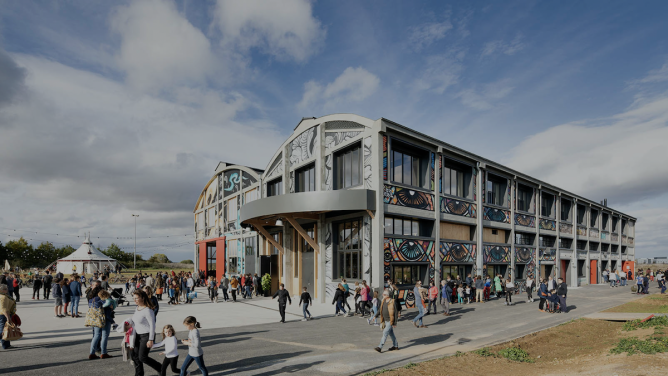In Europe, the construction industry is responsible for around 40% of CO2 emissions and nearly a third of all waste. What’s more, only 40% of construction waste is currently recycled or reused. However, giving waste a second life is most often limited to a few sectors, such as backfilling operations. With the looming environmental crisis, public authorities are trying to mobilize the sector. With the 2008 Waste Directive, Europe has set the recycling rate for construction and demolition waste at 70%. Apart from the environmental impact and regulatory incentives, the arrival of the circular economy in the construction industry is sure to stir up a hornet’s nest and create considerable economic opportunities. Roland Berger estimates an additional global market opportunity of more than €600 billion by 2025.
With this in mind, newcomers entering the construction tech field are arguably best placed to reverse the status quo. By offering a model designed to bring together emerging players and offers in one single place (which has been difficult to do up until now), digital platforms have established themselves as a key accelerator. By connecting fragmented players and centralizing data, as well as AI tool accessibility, material traceability, reuse marketplaces and tool interoperability, platformization is certainly equipping and facilitating the transition.
Reviewing the value chain
By definition, the circular economy transforms the whole construction industry value chain. From building design to material sourcing, construction processes, site management, deconstruction and demolition, the entire building lifecycle offers many opportunities.
Construction tech players are proving to be willing to tackle the issue, as seen by the growing number of dedicated start-ups. From the design phase, a start-up like StructurePal connects directly to BIM platforms to optimize concrete structure design. Thanks to AI-based tools, the Israeli company promises up to a 15% reduction in concrete volume. Similarly, Spacemaker (which was recently acquired by Autodesk) is a cloud-hosted collaboration solution which uses AI to analyze and design projects.
Many remarkable optimization opportunities are also for the taking on construction sites. Hiboo is leading the wave of vehicle fleet management platformization. By centralizing usage data, the French start-up can optimize the use of each tool while supplying its remaining IS (SAP, Salesforce, Azure…). On the materials side of things, Hesus is a platform offering construction materials and waste management and recovery. In 2020, the French start-up achieved an average recovery rate of over 84% on its sites. Still on the topic of waste, the number of marketplaces are increasing, offering outlets for what was still considered as scrap a few years ago. Waste MarketPlace, Trinov and Backacia all use platform scalability to support the growing demand for recycled materials, while enjoying model-specific network externalities. Although Rockease doesn’t target recoverable waste, its platform facilitates the aggregate sourcing and ordering processes by connecting construction companies, production sites and transporters. Meanwhile, the AI behind SustainEcho is designed to reduce a project’s environmental impact by optimizing its carbon footprint, starting from the initial quantity survey. Once a building is completed, it doesn’t stop there: tools like GridPoint and Envio use IoT and data to optimize building operations and increase a building’s lifespan.
Apart from the growing number of startups offering these types of solutions, the platform concept suggests the development of major collective projects capable of accelerating circular dynamics. With Urban Mine Platform, which unites 17 European partners, the EU has acquired a valuable tool for monitoring its e-waste urban mines. This device could easily be expanded to include construction materials…
The challenges surrounding the circular economy
The circular model still has a certain number of obstacles to overcomes if it wants to become more popular throughout the construction sector. The first hurdle is a question of culture: the construction industry is rooted in a linear logic and must develop new reflexes. Current costing methods are based on four factors: land, materials, design and construction. In this context, circular construction remains more expensive. The emergence of new value models which cover the entire lifecycle enables certain certainties to be put into perspective. Once again, digital platforms provide solutions. A tool like Madaster – which defines itself as a digital materials library – promotes and facilitates circular economy by creating an inventory of all resources and materials present in each building.
However, scalability remains a major challenge. Virgin materials are currently widely available at optimized costs, and recycled materials are the exception. As circular marketplaces like those mentioned above gain in popularity, plus a scarcity of raw materials, such as sand, the scales should tip in the coming years.
As new business models are being explored, new building methods are emerging. Concerning modular solutions, Katerra challenges the construction industry’s traditional fragmented structure and markets itself as an “end-to-end” platform as a service. Mastering and understanding the entire building lifecycle suggests an easier and enhanced circular approach. Targeted recruitment and equipment pooling platforms could already be used to achieve this. Platforms like getable, Build2B (read our interview) or EquipmentShare are already surfing this trend.


